Guide to Floral Tea: Rose, Jasmine, Butterfly Pea Flower, and more
by Abby Morrison
June 15, 2021

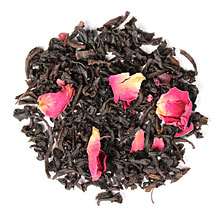
Rose
The classic flower for love and romance, roses have been common in mythology and culture for centuries, from Greek myths to Shakespearean musings to 1980's power ballads. A member of the Rosaceae scientific family, they are related to many stone fruits as well as certain berries, nuts, apples, and pears. They come in a wide variety of colors (commonly white, yellow, pink, and red), and bear small fruits known as rose hips.In tea, roses can be used in several ways. Both the rose hips and the petals can be used for steeping, or rose flavoring can be added. To get started, why not try some of our favorites like White Eternal Spring, Summer Rose, Lychee Rose Green, or Buddha's Dream. Or, use our Advanced Search feature to look through the more than forty rosy teas in our catalog.

Hibiscus
Hibiscus is a tropical plant known for its large, colorful flowers, which come in anything from white to yellow, red, purple, or pink. As culturally significant as they are beautiful, they are the national symbol of Haiti, and the national flower for the Solomon Islands, Niue, South Korea, and Malaysia. In Hawaii, they can even be used to show whether a woman is single or in a relationship depending on where they are worn.In teas, hibiscus brings a bright red color, tart flavor, and a whole lot of Vitamin C. It can be enjoyed either hot or cold, making it the perfect drink for a tropical getaway any time of the year.
If you'd like to give hibiscus a whirl, try it in Hibiscus, Dragon Fruit Dream, Green Rooibos Paradiso, or Watermelon Cooler; or, use our Advanced Search feature to find more.
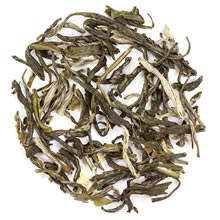
Jasmine
Jasmine flowers are small, white or yellow flowers that grow on jasmine vines or shrubs. Extremely fragrant, they are often used in perfumes, as well as religious ceremonies, weddings, and other celebrations. They are national symbols and flowers in Indonesia, Pakistan, and the Philippines.Unlike other flowers, jasmine flowers are not actually steeped when used in teas. Instead, the aromatic flowers are layered over the tea leaves so that the tea can absorb their scent and flavor. This process is often repeated to enhance the flavor, after which point the petals are removed.
At Adagio, we offer several jasmine teas, including Jasmine Phoenix Pearls, Fujian Jasmine Pearls, Jasmine Yin Hao, Jasmine Silver Needle, Jasmine Chun Hao, and Rooibos Jasmine. If you're not sure where to begin, try our Jasmine Sampler.
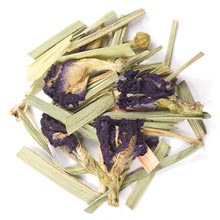
Butterfly Pea Flower
While you might not recognize the name of the Butterfly Pea Flower, if you've ever had a tea with it, you'll remember its startling effect. Butterfly Pea Flowers, also known as Asian Pigeonwings, have the ability to change your usual brown or amber brew into a riveting blue. Add something acidic, like lemon or lime, and the color will change to pink or purple instead.Our Bella Luna Blue only comes around once every blue moon (no, really. Make sure to sign up to be notified when it's available!), so that may not always be an option, but if you're looking for that magical color change year round, don't fret. Butterfly Pea Flowers are now regularly available as part of our pantry. Just add them to any of your favorite teas to surprise guests, dazzle little ones, or add a splash of blue for yourself.
Not to mention two great year-round additions to the Iced Tea range of Blue Mango and Purple Papayaberry!
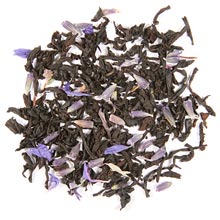
Blue Cornflower
You might know cornflowers best as a crayon color, but did you know they're also beautiful wild flowers native to Europe? Though they were originally labeled as weeds, people have since found broader uses for them both as food for pollinators, pest fighters, ornamental plants, and more. The flower has also been used as a symbol for many royal, political, and military organizations throughout the years, some of which continues on today.In tea, cornflower can be used to add color, mild flavor, or enhance the texture of the tea. We use it in many of our blends, including our Earl Grey teas, which can be bought on their own, as samplers, or in bulk.
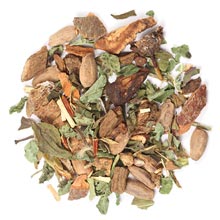
Dandelion
Dandelions are another plant with a weedy reputation. The scourge of yards the world over, these flowers are known for their bright yellow flowers and puffy white seed carriers. The entire plant is edible and used in things like salads, side dishes, wine, and even root beer.In tea, the root is most often used, where it's said to help with liver and gut health. We use dandelion in our Tea-Tox and Skinny Tea.
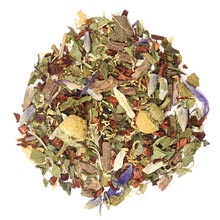
Passionflower
Passionflowers are bright showy flowers that hail from South and Central America. Their name refers to the Passion of the Christ, as the various elements of the flower's unique anatomy were often used by missionaries to share the gospel. They can also be used ornamentally or for their fruit, which has a sweet and tangy flavor.At Adagio, we offer teas with both passionflower and passionfruit. Try passionflower in 40 Winks or Daydream, or use our Advanced Search to find more options.
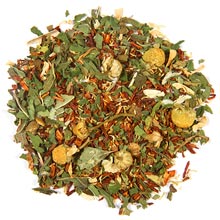
Chamomile and Lavender
Chamomile and Lavender are two floral powerhouses. We've talked about them here before, so make sure to check out our Herbal Guide to learn more.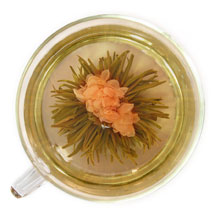
Blooming Teas
Last, but not least, Blooming Teas! These appeal to the eye as much as the palate: each serving is a hand-tied cluster of tea leaves that slowly unfurls in water to reveal a delicate flower hidden within. The splendor of the flower "blooming" in the cup enhances the wondrous taste of tea leaves gathered at the peak of freshness. Enjoy these yourself, or share with those you love.So there you have it, several floral teas to put some extra Spring in your steep. Make sure to use our Advanced Search feature to root out any we missed and share any new favorites you find with us on social @AdagioTeas.